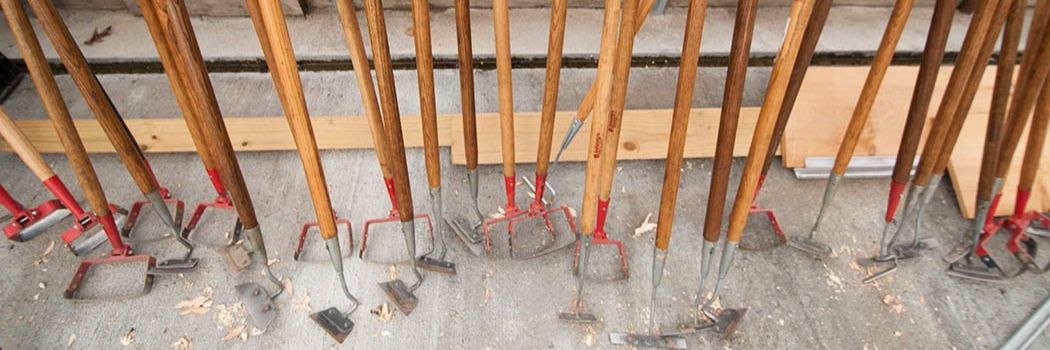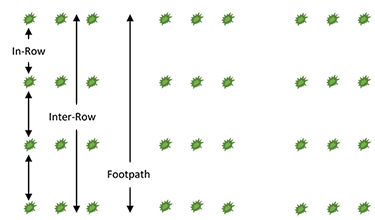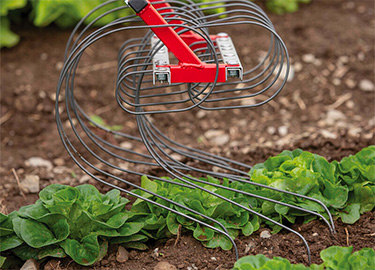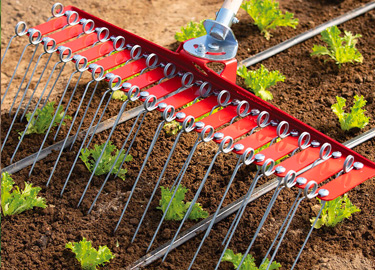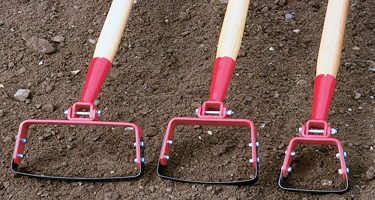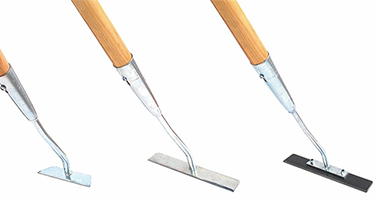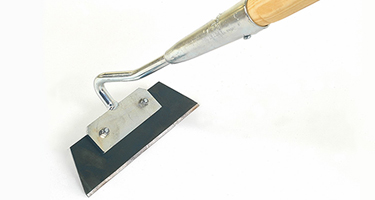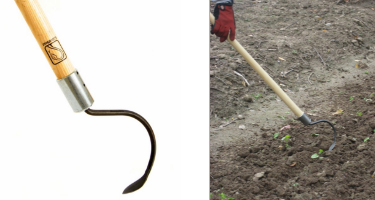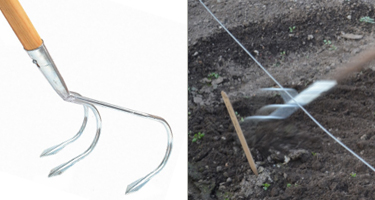- Carrot Growing Guide | Fundamentals of Bed Preparation, Spacing, Weeding & Watering - Part 1
- Collinear Hoes | Tech Sheet (PDF)
- Connecta® Tool System | Assembly & Maintenance | Tech Sheet (PDF)
- Finger Weeders | Instruction Manual (PDF)
- Flame Weeder | Assembly, Backpack Tank Mounting, Usage & Safety Instructions | Tech Sheet (PDF)
- Glaser Wheel Hoe | Double Wheel Conversion Kit | Instruction Manual (PDF)
- Glaser Wheel Hoe | Instruction Manual (PDF)
- Offset Wire Hoe Assembly Instructions | Tech Sheet (PDF)
- Tine-Weeding Rakes | Instruction Sheet (PDF)
- Video: Tine-Weeding Rake Demonstration
- Video: Jack Algiere Demonstrates the Tine-Weeding Rake
- Video: Wire Weeder | Improve Weed Control on the Small Farm
- Video: How to Use & Handle a Silage Tarp to Create a Stale Seed Bed
- Video: Eliot Coleman Demonstrates How to Use Johnny's Collinear Hoe
- Video: Johnny's Flame-Weeder Demonstration
- Video: Using the Glaser Wheel Hoe | Demonstration by Johnny's Selected Seeds
- Video: Johnny's Long-Handled Tools
- Weed Barrier Fabric | Instruction Sheet
- Got Weeds? Targeting Annual & Perennial Weeds
- Weed Management for Sustainable Agriculture | A Two-Pronged Approach
- Long-Handled Weeding & Cultivation Tools | Old & New Favorites
- Wheel Hoe Selection Guide - Find Your Fit
- Wheel Hoe Selection Guide | Tech Sheet (PDF)
- Table of Wheel Hoe Attachments & Compatibilities | Glaser & Terrateck Options from Johnny's
- Johnny's Flame Weeder – 30" | Assembly & Use | Tech Sheet (PDF)
- Connecta® Bed Prep Rake | Connecta Tool System
- Johnny's Flame Weeder Backpack | Instructions for Use | Tech Sheet (PDF)
- Cover Cropping for Field & Garden | Johnny's Educational Webinar Resources
- Terrateck Wheel Hoe Assembly & Instruction Manual | Single and Double Wheel Hoe | in English | (PDF)
- Video: Connecta® Interchangeable Tool System from Johnny's Selected Seeds
- Connecta® Stirrup Hoe | Connecta Tool System
- Johnny's Flame Weeder – 30"
Long-Handled Weeding & Cultivation Tools—Favorites Old & New
Efficient cultivation has always been an important part of keeping weeds in check. Over the past few years, we've expanded our offering of efficient weeding and cultivation tools for small-scale growers. Each of these human-powered long-handled tools is particularly good at one or more types of cultivation. Here's a review of three cultivation types — inter-row, in-row, and footpath weeding — followed by an overview of our newer cultivation tool options then long-time favorites in the long-handled category.
TYPES of CULTIVATION
The three main areas where the long-handled tools in this guide are most useful are between rows, between individual crops in the row, and along footpaths:
1 • INTER-ROW CULTIVATION
Inter-row cultivation, or cultivating between rows of crops in a bed, is the type most commonly accomplished by cultivation tools. Generally the tool passes by the crop, turning over the soil surface and killing nearby weeds.
2 • IN-ROW CULTIVATION
In-row cultivation is achieved by cultivating in-between crops growing in the same row. This is generally more difficult to accomplish by tools drawn parallel to the row, but some innovative tools have been developed to make this possible.
3 • FOOTPATH CULTIVATION
Footpath cultivation is pretty straightforward. The goal is to kill weeds in the path, but also to reduce compaction.
Each of the tools described below is annotated to indicate the type(s) of cultivation it performs best.
NEW WEEDING & CULTIVATION TOOLS for GREATER EFFICIENCY
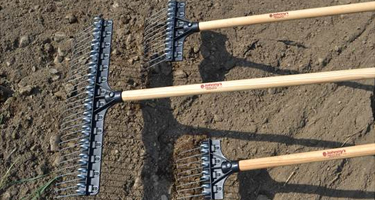
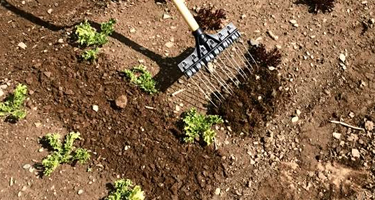
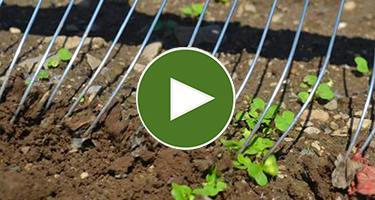
TINE-WEEDING RAKES & HARROWS
1 & 2 • Inter-Row & In-Row Cultivation
Quick and efficient, these are rakes that remove emerging weeds when they are easiest to kill — at thread stage. When drawn over established crops, the tiny weeds are pulled out and the crop is left unharmed and weed-free. Twice-weekly use over established beds will keep weeds in check.
Tine-weeding rakes and harrows are additionally useful for removing debris and cultivating crusty soils, such as those often encountered in overwintering crops, and they leave your drip irrigation setup intact. Varying the downward pressure on the handle will give you the knack to their versatility.
- 21" TINE-WEEDING RAKE
The 21"-wide model is most often used for tine-weeding multiple rows of a high-density seeding, especially those that are tightly spaced such as carrots and greens and salad mixes.
By cultivating the crops while they are young, you can keep salad mixes and greens mixes relatively weed free, improving their marketability and saving labor at harvest time. - 6" & 9" TINE-WEEDING RAKES
The narrower models are best for working between more mature crops that are spaced between 4" and 9" apart. Used this way they can replace any hoe you might use and are much faster and more efficient — as long as the weeds are at thread stage. They can also be used for tine-weeding over single-row crops, or weeding between rows.
- FLEX TINE WEEDERS
With their staggered, curved tines, Flex Tine Weeders are a good choice for cultivating both young and established crops. Larger sizes are excellent for weeding multiple rows of a high-density seeding, while the narrower models are useful for working between more mature crops. - TINE HARROWS
The harrow design provides a more aggressive action than that of the Flex Tine Weeders, with angular teeth that score heavier soils, but which also accommodate crops that form a strappier/less horizontal leaf canopy — think monocots, such as onions. You can also use a tine harrow to level a bedrow, fluff, aerate, or dry it out, or scatter or incorporate amendments pre- or post planting/transplanting, as necessary.
Note that these professional-grade implements feature removeable tines, for greater utility and longevity. By removing the center tines, for example, you can weed both sides of a single-row crop with your rake. Replacement Tine Kits are available for the various models.
Read our Tine Weeding Rake Instruction Sheet for the fundamentals on timing, conditions, and technique…
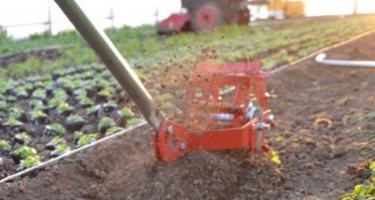
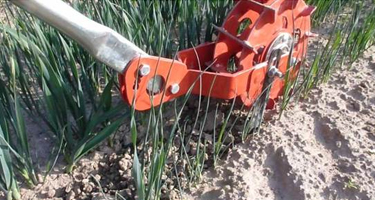
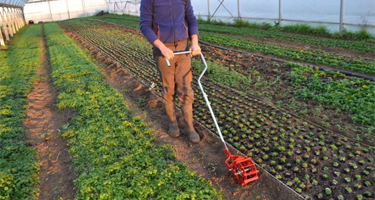
WHEEL WEEDERS
Made in France, these tools are most effective when used at a brisk walking pace. The design effectively combines two actions:
- The undercutting action of a stirrup hoe, with an adjustable blade angle and height, to target larger, established weeds.
- A light soil disturbance, generated by the wheel as it sifts out smaller weeds, from filament-stage up to approximately 4" in length.
Together, these actions pull weedlings out of the soil and leave them high and dry to die at the surface.
5"-WIDE & 7"-WIDE WHEEL WEEDERS
2 • In-Row Cultivation
The two narrower Wheel Weeder models are most useful for cultivating in between multiple crop rows in a bed.
3 • Footpath Cultivation
The widest Wheel Weeder model is well suited to weeding along footpaths.
LONG-TIME LONG-HANDLED FAVORITES
Johnny's long-handled weeding tools have withstood the rigor of time, each with its own unique application. Using the right tool for the right job not only makes work faster and more efficient, but the ergonomic advantages offered by a well-designed tool can even make work enjoyable. Skeptical? Let's take a look…
STIRRUP HOES
1, 2 & 3 • Inter-Row, In-Row & Footpath Cultivation
Our most popular hoe to date. Why? Efficiency, versatility, durability.
The Stirrup Hoe is an all-around hoe that can cover ground in a hurry. A root-slicing hoe designed to cut on both the forward and reverse strokes, it is especially adept at inter-row weeding and keeping the footpath under control. The blade is Swiss-made of spring steel, rugged enough to take on more mature weeds yet rounded, to allow the user to weed up close to the crop without damaging it.
We offer three different models: 3¼" wide, 5" wide, and 7" wide, all sporting a beefy ashwood handle to support the extra stress involved with the push stroke. Replacement Blades are available as well, when the time comes.
COLLINEAR HOES
1, 2 & 3 • Inter-Row, In-Row & Footpath Cultivation
The Collinear Hoe is a truly unique, extremely popular tool designed by Eliot Coleman, with a sharp, rectangular blade that lies flat against (collinear with) the ground. It is a type of "draw hoe" that is pulled toward the user to slice weeds off just below the soil surface, leaving them to wither and die.
The Collinear Hoe is versatile but especially effective in and around low-lying foliage crops, such as head lettuce.
It was designed to be ergonomic from its very inception. The intention was to create a hoe that could be used in a vertical stance, to minimize lower back strain. The tool is held in this position with a thumbs-up grip, much as you would a kitchen broom. It can be drawn in a back-and-forth motion for conditions of lighter weed pressure, or more aggressively as a draw hoe to slice out more mature weeds.
Read our Collinear Hoe Instruction Sheet for more details…
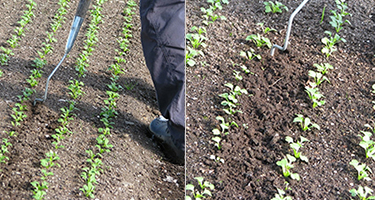
Here's a quick clip of the Wire Weeder in action at the University of Maine School of Sustainable Ag • WATCH…
The WIRE WEEDER
1 & 2 • Inter-Row & In-Row Cultivation
Here is another highly ergonomic weeder designed by Eliot Coleman, this one with surgical precision in its application. Like the Collinear Hoes, the Wire Weeder is designed to be used with a straight back and both thumbs up.
It is great for emerging weeds, especially in and around younger crops or closely-spaced crops, where clumsiness just will not do. It is somewhat blunt, so as not to cut through the weeds but to overturn them, exposing their roots to the sun.
We also offer a Short-Handled Wire Weeder.
The TRAPEZOID HOE
1, 2 & 3 • Inter-Row, In-Row & Footpath Cultivation
This is a design that is especially useful for mid-sized weeds — a traditional chopping hoe with a unique, trapezoidal shape. The beveled spring steel blade is angled just enough to get under the edges of plants. Sharp corners tackle stubborn roots.
We offer a 5"-wide and a 6½"-wide version, as well as Replacement Blades for both Trapezoid Hoes, should they need swapping out once seasons of vigorous use have taken their toll.
The COBRAHEAD®
1 & 2 • Inter-Row & In-Row Cultivation
The curved blade of the CobraHead acts like a steel fingernail. It weeds, cultivates, digs, and furrows with ease, in almost any soil type.
The blade is forged of high-quality steel to last many seasons, but is set in place with Allen screws, so it can easily be swapped out for a Replacement Blade should it ever become necessary.
The 3-TOOTH CULTIVATOR
2 & 3 • Inter-Row & Footpath Cultivation
This tool was designed by Eliot Coleman to be used with a push-pull action for incorporating compost and fertilizer, and loosening soil. What's that got to do with weeding? Well, it can also be used for cultivating between rows and in footpaths, and is especially effective on emerging weed seedlings in those areas as the cultivating action of its teeth buries those young weeds, smothering them.
LEARN MORE about Sustainable Weed Management
- Johnny's Wheel Hoe Selection Guide provides key particulars on this time-tested, human-powered cultivation modality.
- A Two-Pronged Approach to Season-Long Weed Control, by Eric Gallandt, PhD, Weed Ecologist, University of Maine
- Got Weeds? Targeting Annual & Perennial Weeds
- Flame-weeding Tutorial, by Jean–Martin Fortier, Les Jardins de la Grelinette, St-Armand, Québec


